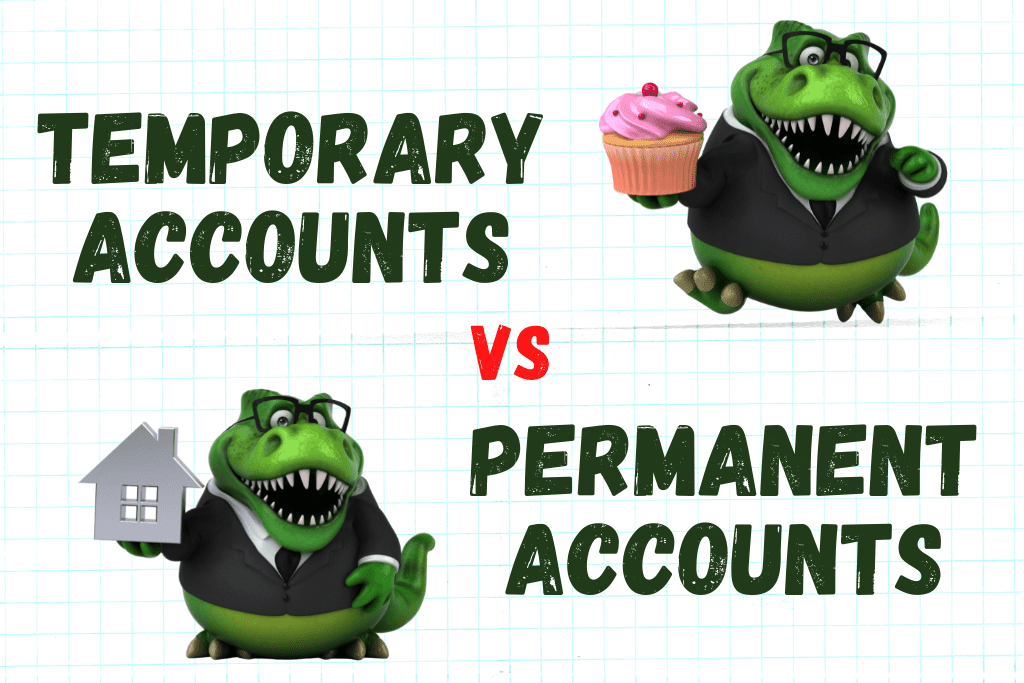In accounting, Permanent accounts carry a balance from one month to the next. Temporary accounts are zeroed out at the end of each month. Permanent accounts are the balance sheet accounts, Assets, Liabilities, and Equity. Permanent accounts are also referred to as real accounts.
Temporary accounts are the income statement accounts, Revenues and Expenses. Temporary accounts are also referred to as nominal accounts. Temporary accounts are closed out (returned to a zero balance) each month to prepare the accounts to accumulate the next month’s revenues and expenses. Closing of temporary accounts is part of the normal accounting cycle.
To learn more about the accounting cycle, check out this video:
Why Do Permanent Account Balances Carry Over?
Permanent accounts represent what a business owns and what a business owes. An example of this in personal finance would be the ownership of a house (an asset), the mortgage on that house (a liability), and the difference between the two (asset minus liability) is equity. The value of the house and the balance of the mortgage impact multiple accounting periods (months and years).
In a business, the assets, liabilities, and equity accounts will be tracked over the life of the business. As such, the balances will be updated each month–assets increasing and decreasing, liabilities increasing and decreasing, equity increasing and decreasing–so the business always has an accurate picture of what is owned and owed.
Why Don’t Temporary Account Balances Carry Over?
Temporary accounts represent the current month’s activity, the revenue and expenses for current operations. In accounting, being able to run reports based on a time period is critical for understanding the relationship between revenue and expenses.
Before the advent of accounting software, the only method available to capture balances by the month was to do closing entries to zero out the revenue and expense accounts to prepare them for collecting a new month of information.
For more about closing entries, check out this article and accompanying video:
Examples of Permanent Accounts
The following is a listing of common permanent accounts:
- Cash
- Accounts Receivable
- Inventory
- Prepaid Insurance
- Prepaid Rent
- Vehicles
- Buildings
- Accumulated Depreciation
- Accounts Payable
- Wages Payable
- Unearned Revenue
- Notes Payable
- Mortgage Payable
- Current Portion of Long-term Debt
- Owner’s Equity
- Partners’ Equity
- Members’ Equity
- Stockholders’ Equity
- Treasury Stock
- Common Stock
- Preferred Stock
- Retained Earnings
Examples of Temporary Accounts
The following is a listing of common temporary accounts:
- Revenue
- Sales
- Sales Revenue
- Fees Earned
- Professional Fees
- Service Revenue
- Rental Income
- Interest Revenue
- Advertising Expense
- Rent Expense
- Insurance Expense
- Depreciation Expense
- Cost of Goods Sold
- Cost of Merchandise Sold
- Supplies Expense
- Salaries and Wages Expense
- Interest Expense
- Dividends or Owner’s Withdrawals (balance transfers to Equity)
- Gain or Loss accounts
Why Are Closing Entries Necessary?
Closing entries serve two purposes:
- Prepare revenue and expense accounts to collect period-specific data by zeroing out previous activity. Think of this like a scoreboard in a baseball game. At the end of the game the scoreboard returns to zero in preparation for the new game.
- Transferring profits (Revenue – Expenses) to Retained Earnings (equity) and dividends or owner’s draw to equity.
Are Closing Entries Needed When Using Accounting Software?
Closing entries are not needed when using accounting software like QuickBooks, Xero, or Freshbooks. Because accounting software allows for date-driven reports to present financial information for any specified period of time, closing entries as part of the accounting process are not prepared. The software does this behind the scenes.
Closing entries are taught in accounting classes to help students understand the accounting process and how financial information moves through the accounting software.
For more information about what accounts are found on Financial Statements, check out this article:
-
How to Know What to Debit and What to Credit in Accounting
If you’re not used to speaking the language of accounting, understanding debits and credits can seem confusing at first. In this article, we will walk through step-by-step all the building
-
How to Analyze Accounting Transactions, Part One
The first four chapters of Financial Accounting or Principles of Accounting I contain the foundation for all accounting chapters and classes to come. It’s critical for accounting students to get
-
What is an Asset?
An Asset is a resource owned by a business. A resource may be a physical item such as cash, inventory, or a vehicle. Or a resource may be an intangible
-
What are Closing Entries in Accounting? | Accounting Student Guide
What is a Closing Entry? A closing entry is a journal entry made at the end of an accounting period to reset the balances of temporary accounts to zero and
-
What is a Liability?
A Liability is a financial obligation by a person or business to pay for goods or services at a later date than the date of purchase. An example of a
-
What is Revenue?
Revenue is the income generated by a business in the normal course of operations. It represents the sale of goods and services to customers or clients. For a non-profit organization,

